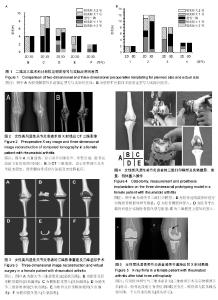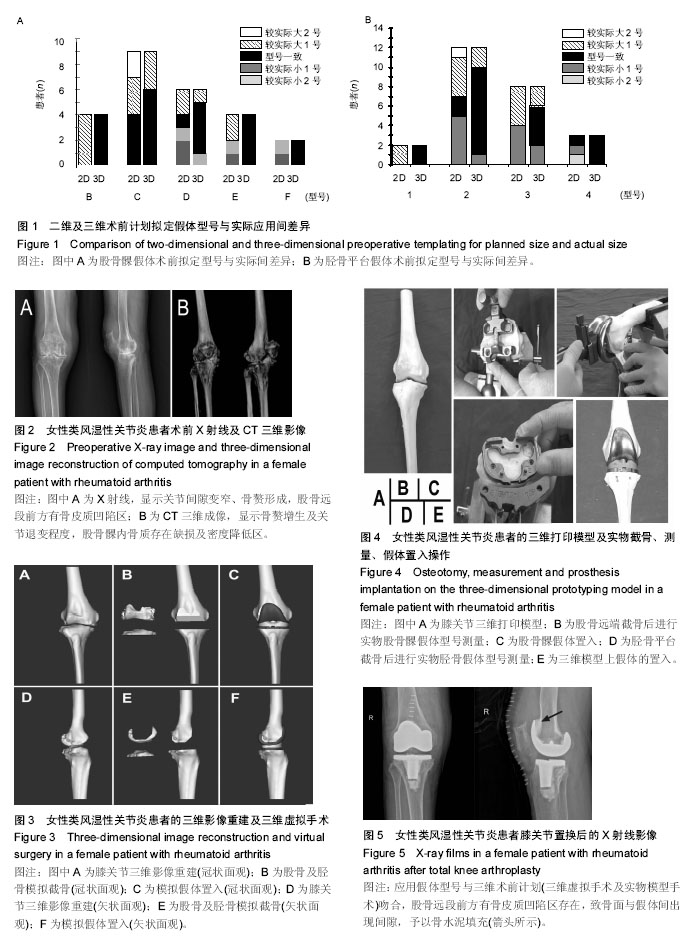| [1] Fawzy E,Pandit H,Jenkins C,et al.Determination of femoral component size in unicompartmental knee replacement.Knee.2008;5(15):403-406.
[2] 丁裕润,王伟力.CT三维重建在全膝关节置换中的应用[J].中国组织工程研究,2012,16(48):9020-9024.
[3] Tyagi V,Kim TH,Hwang JH,et al.Imageless navigation assisted total knee arthroplasty with comprehensive gap balancing in medial osteoarthritic varus knees with anatomic variations.Comput Aided Surg.2010;15(4-6): 90-97.
[4] van der Linden-van DZH,Wolterbeek R,Nelissen RG.Computer assisted orthopedic surgery; its influence on prosthesis size in total knee replacement. Knee.2008;15(4):281-285.
[5] Friederich N,Verdonk R.The use of computer-assisted orthopedic surgery for total knee replacement in daily practice: a survey among ESSKA/SGO-SSO members. Knee Surg Sports Traumatol Arthrosc.2008; 16(6): 536-543.
[6] Unnanuntana A,Arunakul M,Unnanuntana A.The accuracy of preoperative templating in total knee arthroplasty.J Med Assoc Thai.2007;90(11):2338-2343.
[7] Arora J,Sharma S,Blyth M.The role of pre-operative templating in primary total knee replacement.Knee Surg Sports Traumatol Arthrosc.2005;13(3):187-189.
[8] Aslam N,Lo S,Nagarajah Ket al.Reliability of preoperative templating in total knee arthroplasty.Acta Orthop Belg.2004;70(6):560-564.
[9] Lonner JH, Laird MT,Stuchin SA.Effect of rotation and knee flexion on radiographic alignment in total knee arthroplasties.Clin Orthop Relat Res.1996;331: 102-106.
[10] Won SH,Lee YK,Ha YC,et al.Improving pre-operative planning for complex total hip replacement with a Rapid Prototype model enabling surgical simulation.Bone Joint J.2013;11(95-B):1458-1463.
[11] Mazzoni S,Marchetti C,Sgarzani R,et al.Prosthetically guided maxillofacial surgery: evaluation of the accuracy of a surgical guide and custom-made bone plate in oncology patients after mandibular reconstruction. Plast Reconstr Surg.2013;131(6): 1376-1385.
[12] Olszewski R.Three-dimensional rapid prototyping models in craniomaxillofacial surgery:systematic review and new clinical applications.P Belg Roy Acad Med.2013;11(2):43-77.
[13] Sciberras N,Frame M,Bharadwaj RG,et al.A novel technique for preoperative planning of severe acetabular defects during revision hip arthroplasty. Bone Joint J.2013;95B(Suppl 30):63.
[14] Lee M,Wu BM.Recent advances in 3D printing of tissue engineering scaffolds. Methods Mol Biol.2012; (868):257-267.
[15] Levine JP,Patel A,Saadeh PB,et al.Computer-aided design and manufacturing in craniomaxillofacial surgery: the new state of the art.J Craniofac Surg. 2012;23(1):288-293.
[16] Sun W,Li J,Li Q,et al.Clinical effectiveness of hemipelvic reconstruction using computer-aided custom-made prostheses after resection of malignant pelvic tumors. J Arthroplasty.2011;26(8):1508-1513.
[17] 汪光晔,张春才,许硕贵,等.基于真实CT数据骨科虚拟手术计划在髋臼骨折手术中的运用[J].中国组织工程研究与临床康复,2011,15(43):7987-7990.
[18] Rengier F,Mehndiratta A,von Tengg-Kobligk H,et al.3D printing based on imaging data: review of medical applications.Int J Comput Assist Radiol Surg. 2010; 4(5):335-341.
[19] He J,Li D,Lu B,Wang Z,et al.Custom fabrication of a composite hemi-knee joint based on rapid prototyping. Rapid Prototyping J.2006;12(4):198-205.
[20] Franceschi JP,Sbihi A.3D templating and patient-specific cutting guides (Knee-Plan) in total knee arthroplasty: postoperative CT-based assessment of implant positioning. Orthop Traumatol Surg Res.2014;100(6 Suppl):S281-S286.
[21] Costa AJ,Lustig S,Scholes CJ,et al.Can tibial coverage in total knee replacement be reliably evaluated with three-dimensional image-based digital templating? Bone Joint Res.2013;2(1):1-8.
[22] Brooks P.Seven cuts to the perfect total knee. Orthopedics. 2009;32(9):27.
[23] 王军帅,姜娥先,魏本和,等.双下肢全长负重位与非负重位摄影在全膝关节置换术前评估的研究[J].医学影像学杂志,2014,24(9):1608-1611.
[24] 吴昊,邱维加,Van Driessche Stéphane,等.计算机辅助下相关数字影像资料对人工全膝关节置换术的优化作用[J].中国临床康复,2005,9(22):1-3.
[25] 王新光,史占军,郭汉明,等.术前胫骨力线X线定位对提高膝关节置换术后假体力线的作用[J].实用医学杂志,2015, 31(16):2669-2672.
[26] Howcroft DW,Fehily MJ,Peck C,et al.The role of preoperative templating in total knee arthroplasty: comparison of three prostheses.Knee.2006; 13(6): 427-429.
[27] The B,Diercks RL,van Ooijen PM,et al.Comparison of analog and digital preoperative planning in total hip and knee arthroplasties. A prospective study of 173 hips and 65 total knees.Acta Orthop.2005;76(1):78-84.
[28] Heal J,Blewitt N.Kinemax total knee arthroplasty: trial by template.J Arthroplasty.2002;17(1):90-94.
[29] Swanson KE,Stocks GW,Warren PD,et al.Does axial limb rotation affect the alignment measurements in deformed limbs?Clin Orthop Relat Res.2000;371: 246-252.
[30] Bothra V,Lemon G,Lang D,et al.Reliability of templating in estimating the size of uni-condylar knee arthroplasty. J Arthroplasty.2003;18(6):780-783.
[31] Sparmann M,Wolke B,Czupalla H,et al.Positioning of total knee arthroplasty with and without navigation support.A prospective, randomised study.J Bone Joint Surg Br. 2003;85(6):830-835.
[32] Gervaise A,Naulet P,Beuret F,et al.Low-dose CT with automatic tube current modulation, adaptive statistical iterative reconstruction, and low tube voltage for the diagnosis of renal colic: impact of body mass index.AJR Am J Roentgenol. 2014;202(3):553-560. |

